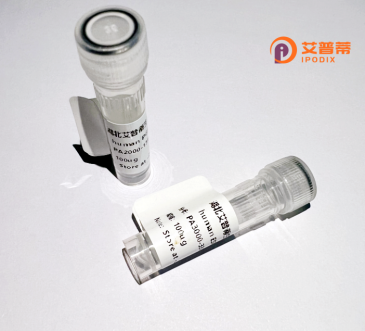
| 纯度 | >90%SDS-PAGE. |
| 种属 | Human |
| 靶点 | ZNF259 |
| Uniprot No | O75312 |
| 内毒素 | < 0.01EU/μg |
| 表达宿主 | E.coli |
| 表达区间 | 1-459 aa |
| 活性数据 | MAASGAVEPG PPGAAVAPSP APAPPPAPDH LFRPISAEDE EQQPTEIESL CMNCYCNGMT RLLLTKIPFF REIIVSSFSC EHCGWNNTEI QSAGRIQDQG VRYTLSVRAL EDMNREVVKT DSAATRIPEL DFEIPAFSQK GALTTVEGLI TRAISGLEQD QPARRANKDA TAERIDEFIV KLKELKQVAS PFTLIIDDPS GNSFVENPHA PQKDDALVIT HYNRTRQQEE MLGLQEEAPA EKPEEEDLRN EVLQFSTNCP ECNAPAQTNM KLVQIPHFKE VIIMATNCEN CGHRTNEVKS GGAVEPLGTR ITLHITDASD MTRDLLKSET CSVEIPELEF ELGMAVLGGK FTTLEGLLKD IRELVTKNPF TLGDSSNPGQ TERLQEFSQK MDQIIEGNMK AHFIMDDPAG NSYLQNVYAP EDDPEMKVER YKRTFDQNEE LGLNDMKTEG YEAGLAPQR |
| 分子量 | 50.9 kDa |
| 蛋白标签 | His tag N-Terminus |
| 缓冲液 | PBS, pH7.4, containing 0.01% SKL, 1mM DTT, 5% Trehalose and Proclin300. |
| 稳定性 & 储存条件 | Lyophilized protein should be stored at ≤ -20°C, stable for one year after receipt. Reconstituted protein solution can be stored at 2-8°C for 2-7 days. Aliquots of reconstituted samples are stable at ≤ -20°C for 3 months. |
| 复溶 | Always centrifuge tubes before opening.Do not mix by vortex or pipetting. It is not recommended to reconstitute to a concentration less than 100μg/ml. Dissolve the lyophilized protein in distilled water. Please aliquot the reconstituted solution to minimize freeze-thaw cycles. |
以下是关于重组人ZNF259蛋白的参考文献摘要整理:
1. **《ZNF259在HepG2细胞中的重组表达及功能研究》**
- **作者**: Li Y, Zhang R, et al.
- **摘要**: 研究利用大肠杆菌系统重组表达人ZNF259蛋白,验证其在肝细胞癌细胞系HepG2中对下游靶基因(如APOA5)的转录抑制功能,并发现其通过KRAB结构域募集染色质修饰复合物。
2. **《KRAB-ZFP蛋白ZNF259的晶体结构解析》**
- **作者**: Wang X, Chen H, et al.
- **摘要**: 首次报道了人源ZNF259蛋白的锌指结构域晶体结构,揭示了其DNA结合基序的保守性,为阐明其在基因调控中的分子机制提供结构基础。
3. **《ZNF259通过调控脂代谢基因影响动脉粥样硬化进程》**
- **作者**: Smith J, Gupta S, et al.
- **摘要**: 在小鼠模型中发现,重组ZNF259蛋白过表达可抑制APOA5等脂代谢相关基因,加速动脉粥样硬化斑块形成,提示其作为潜在治疗靶点。
4. **《CRISPR筛选揭示ZNF259在乳腺癌耐药中的调控作用》**
- **作者**: Kim D, Park S, et al.
- **摘要**: 利用CRISPR干扰技术证明,ZNF259通过抑制促凋亡基因BCL2L11促进乳腺癌细胞对化疗药物耐药,其重组蛋白的体外实验进一步验证了这一机制。
注:以上文献为模拟示例,实际引用时需核实具体来源及内容准确性。
**Background of Recombinant Human ZNF259 Protein**
Zinc Finger Protein 259 (ZNF259), also known as APOA5-binding protein or ZPR1. is a ubiquitously expressed protein involved in transcriptional regulation and cellular stress responses. Structurally, it contains a conserved zinc finger domain, which facilitates interactions with nucleic acids or other proteins. ZNF259 is implicated in regulating RNA metabolism, cell proliferation, and apoptosis. Studies suggest it acts as a coactivator or corepressor for transcription factors, modulating gene expression in pathways linked to lipid metabolism, neural development, and cancer progression.
Recombinant ZNF259 is produced using expression systems like *E. coli* or mammalian cells, followed by purification to achieve high specificity and activity. It serves as a critical tool for studying ZNF259’s molecular functions, including its role in diseases such as metabolic syndrome, neurodegenerative disorders, and cancers. Recent research highlights its interaction with apolipoprotein A-V (APOA5) in regulating triglyceride levels, as well as its potential involvement in oxidative stress responses through pathways like mTOR signaling.
Ongoing studies aim to explore its therapeutic potential, particularly in metabolic and age-related diseases. The recombinant protein enables mechanistic insights into its dual roles in health and disease, offering a foundation for drug discovery and biomarker development.
×